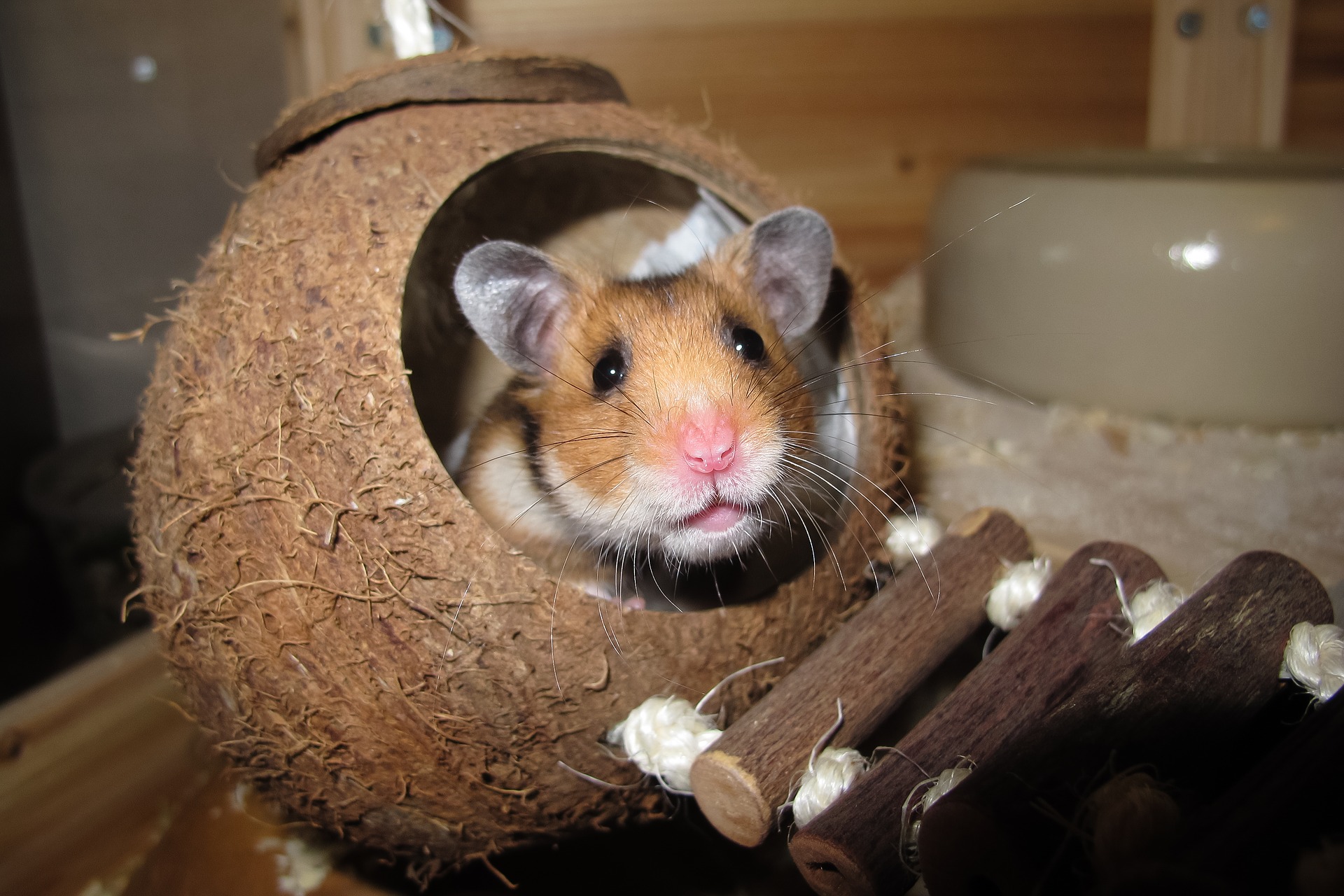As far as animal sizes go, hamsters are certainly on the smaller end of the spectrum; however, despite their size, they don’t half get about! Luckily, there are plenty of hamster cages out there that will help your hamster contained while at the same time letting them release their oodles of energy (they really are full of beans!). In fact, hamsters have been known to run as much as five miles every single night when looking for places to burrow and stay safe, so choosing the right cage for your hamster will not only give them the space they need to be safe and secure but also healthy too.
When considering which hamster cage might be best for your dwarf or Syrian hamster(s), it’s imperative to take into consideration a hamster’s natural activity and predisposition, which, as we’ve discussed above, is running around covering lots of ground and expending their enormous reserves of energy. This means opting for as big a cage as you can afford is probably the best option. Of course, there’s more to hamster cages (and choosing a hamster cage) than size, but it is certainly one of the most critical factors if you want your furry friend to be happy and healthy. This is more important for Syrian hamsters compared to dwarf hamsters as the former is bigger, but just because the latter are smaller doesn’t mean they don’t require lots of space.
But buying a hamster cage isn’t simply about buying a cage. Your hamster will not be a happy chappy if there’s nothing for them to interact and play with, such as wheels, balls, chews treats, tunnels, etc. Keeping your hamster in physical shape and keeping their brain active should always be your goal, regardless of which type of hamster you own. Inactive hamsters are prone to issues with their back legs, so it’s absolutely imperative to give your hamster(s) as much space as possible and encourage them to be as active as possible too.
What type of hamster cage is best?
As stated above, buying the biggest cage you can for your Syrian or dwarf hamster is always the best way to go. However, if you’ve browsed online or in your local pet store, you’ll be aware that different hamster cages are made from different materials, which naturally leads to the questions, ‘What type of hamster cage is best?’.
In this section, we’re going to examine the three main types of hamster cage as this will help you decide which option might be best for you.
#1 – Wire Hamster Cages
As the name suggests, this type of hamster cage is primarily constructed from thin metal parts that sit atop a plastic tray. Wire hamster cages are typically easy to clean and are the best type where ventilation is concerned; however, some owners find their hamster(s) kick bedding through the bars, causing a mess on the floor below. That being said, that doesn’t always happen and only takes a second to clean up, so if you’re not bothered by a little mess here and there, a wire cage might be the best choice for you.
#2 – Modular Hamster Cages
Modular hamster cages are typically made of plastic and commonly come with the option of adding extra features to them, such as tunnels, wheels, extra tubes etc. This type of cage is the perfect choice if you have lots of available room and are keen to continue expanding your hamster cage as time goes on. I had one of these when I was younger, and by the time I’d finished (about one year into my hamster’s life), it nearly took up half of my bedroom! However, modular cages aren’t as well ventilated as wise cages and are a little harder to clean. Luckily, some brands offer wire/modular hybrid cages, which are great if you want the best of both worlds.
#3 – Glass Aquariums
The third most popular type of hamster’ housing’ is the glass aquarium. Although not quite as popular as the above two options, they’re still a preferred option for many hamster owners. The pros of using a glass aquarium for your hamster cage are that they contain bedding better than any other type of cage and your hamster is likely to be more visible; however, they are a little more challenging to clean and aren’t as well ventilated as wire or modular cages.
In recent years, there has been an influx of wooden hamster cages into the market. Although wood is a much more sustainable and eco-friendly material, hamsters really do love a good chew on wood, so always think about this before buying a wooden hamster cage. Of course, if you can provide plenty of other things for them to chew on, it might not be a huge issue, but it’s not like you can train them to chew on a certain toy or chew rather than their wooden home, is it?!
What should you consider before buying a hamster cage?
Now we’ve looked at the most popular types of hamster cages currently available on the market, it’s time to look at other factors that should be considered. Although we have touched upon some of these above, it’s important to go into a little greater detail so as to give you a better understanding prior to purchase. When viewing a potential hamster cage, ask yourself the following:
Is it easy to clean?
Generally speaking, wire cages with plastic bottoms are the easiest type of hamster cage to clean. All you need to do is remove the top wire section, take out the bedding, and give it a wipe down. The more complex a cage is, the harder it will be to clean. When looking at hamster cages, always think about how easy (or difficult) they might be to clean. For example, cages with lots of tubes will require more time to clean as you’ll have to remove each individual tube. A grandiose cage might look great, but think about how much time it will take to clean.
Is it well ventilated?
To ensure your hamster has a happy and healthy environment to live in, adequate ventilation is essential. If your hamster’s cage isn’t sufficiently ventilated, it may reduce the air quality and lead to condensation, resulting in mould growth – not exactly a nice home for your furry friend, is it? This is more likely to happen in a plastic or glass cage, but that doesn’t mean that these types of cages can’t be well ventilated; it just requires a thoughtful and careful layout inside the cage. Even though wire cages are more well ventilated, it also means that they’re more susceptible to drafts, so it’s essential to consider this when thinking about cage type and location.
Is it safe and secure?
If buying a wire cage (or any type of cage with some form of wire in it), the bars should be no more than 1cm apart; otherwise, it will be far more hazardous for your hamster than narrower bars. Horizontal bars will allow your hamster to climb, so ensure you’re able to place a soft landing area underneath to ensure a safe space should they fall. Always check all doors and hinges to ensure they’re secure and won’t open if your hamster decides to put their full weight and force into it. If considering a cage with numerous floors, always check that there are no ways to fall more than one storey down.
Have you thought about chewing?
Hamsters love (and need) to chew and the wire bars of a wire hamster cage are the perfect opportunity for them to do this. While this isn’t necessarily a problem by itself, it can be pretty noisy at times, and if your hamster becomes obsessed with doing so, they might gnaw at the bars continuously! If this is something that may bother you, think about a plastic or glass cage, as these give your hamster far fewer things to chew on. However, if you do opt for a plastic cage, always ensure there aren’t any exposed pieces of plastic where they can start chewing; otherwise, you may find they’ve escaped through a hamster-seed hole within a matter of days! Aquariums are pretty much chew-proof, but always ensure the top is 100% secure.
Where will you put a wheel?
Hamsters need to stay physically active, and as they’re nocturnal creatures, it’s important to give them an outlet, i.e. something they can use to get in their daily exercise without enquiring your help. A wheel is the perfect choice for this as they will go round and round until they’re exhausted, then off to bed they’ll go! Firstly, you must think about where the wheel will go (some cages come with a wheel), and secondly, whether or not it will be big enough for your hamster. All wheels will be big enough for a dwarf hamster, but given that Syrian hamsters are bigger, smaller wheels will not be suitable.
How much potential bedding depth?
Regardless of which type of cage you opt for, it’s essential to provide your hamster with a nice thick layer of bedding for them to burrow down into. This isn’t really too much of a concern with plastic or glass cages, but if a wire cage is what you’ve decided upon, ensure that the plastic tray is at least 10cm deep or as close to 10cm as possible (more is better). Hamsters, by their very nature, are burrowing animals, so by giving them deep bedding, you’ll allow them to feel completely at home and burrow until their heart’s content!
The Best Hamster Cages for Dwarf and Syrian Hamster: Our Top Picks
#1 – Best Overall – Savic ‘Hamster Heaven’ Cage – 80cm x 50cm x 50cm
Yes, I know what you’re thinking; something along the lines of ‘hamster heaven, really?!’ no doubt, and yes, that’s what went through my head when I first saw this hamster cage. This wasn’t because I thought it was a silly name (it’s actually a pretty decent name and one sure to intrigue potential buyers); it was because a name like ‘hamster heaven’ must live up to its lofty billing; otherwise, it’s going to get slammed by reviewers.
Now, the fact that this hamster cage is our number one pick kind of gives the game away; however, it’s worth mentioning the above simply because sometimes products with questionable names can actually be outstanding!
Anyway, now we’ve broached the subject of the name; let’s take a look at why this cage is number one on our list of the best hamster cages for dwarf and Syrian hamster cages. To do this, we’ll split it into the following five categories: size, accessories, safety, ventilation, ease of cleaning, and value for money.
Size: As mentioned at several points throughout this article, size really is important as it allows your hamster to replicate what they would do in the wild (as much as is possible in a confined space). This cage measures a whopping 80cm long by 50cm high and 50cm wide, which really is a monster of a cage. You’d have absolutely no problem housing two Syrian hamsters in it or potentially even three dwarf hamsters, which shows just how big this cage from Savic really is.
Accessories: A big cage is great for ensuring your hamster stays physically healthy, but without the right accessories, they’ll be unable to stimulate their brains and keep their mental health in tip-top shape. Luckily, Savic has included a wealth of accessories with a cage to ensure your hamster has plenty to do, as well as somewhere comfy to sleep.
The cage comes with two sleeping huts, two additional floors in addition to the ground floor (which is super deep, making it perfect for deep bedding), two ramps, an exercise wheel, and an extended tunnel system that leads to a top floor ‘penthouse’. In short, it has everything your hamster needs to live a happy, healthy, and comfortable life. Plus, it comes complete with a water bottle too.
Safety: What we really like about this cage is how safe it is. Although it’s a big cage, its size is in its length rather than height, meaning that even if your hamster falls from one of the two upper levels, the fall wouldn’t be anywhere near as bad as a fall from the upper levels of a taller cage (if you ensure there’s a deep layer of bedding in the bottom tray they’ll have a pillow-like landing!). Plus, only the outer shell is made from a wireframe (with less than 1m between the bars, which is ideal), meaning that there’s no chance of your furry friend get their feet or legs stuck, as can happen with a wire bar floor. The only small downside we envisage is the potential to chew on all the plastic bits of the cage, but provided you supply your hamster with plenty of other things to chew (treats, empty toiler rolls etc.), this shouldn’t present an issue.
Ventilation: Given that this is predominantly a wire cage, the ventilation is going to be good as standard. Although the base is quite deep and there are an array of accessories, the airflow throughout the cage is more than adequate, so you’ll never need to worry about condensation, mould, or anything else associated with lack of proper ventilation. On the flip side, it’s important to keep this cage away from drafts.
Ease of cleaning: On a scale of one to ten, one being almost impossible to clean and ten being very, very easy to clean, this cage ranks an eight. The wire cage is easy to remove, which make accessing the rest of the cage and accessories very easy. The plastic parts of the cage, which includes everything aside from the outer wire frame shell, are super easy to both remove and clean, making the job quick and stress-free. The only real it scores an eight rather than a nine or ten is because the long tunnels included with the cage are quite difficult to clean, and you’ll need a pipe-cleaner type tool to ensure you’ve done a thorough job. Of course, we’re not saying it’s too difficult, just that it takes a little extra time to ensure they’re thoroughly cleaned and rinsed.
Value for money: At 75, this may seem an expensive cage; however, when you take into consideration its size, the number of accessories included, and all of the above mentioned plus points, it’s a no brainer in your opinion. If your hamster lives for three years, that’s the equivalent of 25 per year or a fraction over 2 per month, which is a bargain if you think about it from that perspective. Although there are cages just as big (or perhaps even a little bigger) available on the market, 75 is outstanding value given everything you get.
Overall verdict: There’s a reason, well, more than one reason, why the Savic Hamster Heaven hamster cage sits atop our list of the best cages for both dwarf and Syrian hamsters. Firstly, it’s a massive cage; secondly, it comes with numerous accessories, all of which will help to ensure your hamster has a happy, healthy, and. (Hopefully) long life; thirdly, it’s one of the safest hamster cages we’ve ever tested (and we’ve tested a lot); fourthly, it’s well ventilated; and lastly, it won’t take long to clean. Add in the fact that for its size and the accessories included, and excellent value, it’s clear why this hamster cage is our top pick.
#2 – Best for Dwarf Hamsters – Little Friends Hamster Cage with Wooden Shelf and Ladder – 77cm x 47cm x 36cm
Size: Being smaller than Syrian hamsters, dwarf hamsters require a little less space; however, that doesn’t mean you should opt for a small cage, merely one that is a little smaller than some of the larger cages available on the market. This cage from Little Friends measures 77cm in length, 47cm in width, and 36cm in height, which makes it a decently sized cage regardless of what type of hamster you’ve got. That being said, a dwarf hamster, in this case, is like one human living in a four-bedroom house, i.e. very spacious! If you own a single dwarf hamster, this should definitely be on your list of potential cages as it will provide your furry friend with huge amounts of space to run, burrow, and do everything else hamsters love to do! Could you fit two dwarf hamsters in this cage? Potentially yes.
Accessories: The cage comes with several accessories, including a ladder and a shelf (both wooden), a plastic exercise wheel, a food bowl, and a sleeping hut. Although this isn’t as extensive an array of accessories as you get with some cages, it covers pretty much all bases, aside from a water bottle which can be picked up for a few extra quid.
What we do like about this hamster cage package is its use of a wooden shelf and ladder, which is more sustainable and eco-friendly than plastic. Although people think that wooden hamster cages and/or accessories are more ‘chewable’ than plastic parts, this isn’t really the case, as hamsters will chew on anything of they’re bored. The key here is to ensure they don’t get bored! A few extra accessories such as a chew bar, treats, and empty toilet rolls are perfect for keeping your hamster entertained.
Safety: As this cage only has two floors, i.e. the bottom plastic tray and a raised wooden shelf, we’d class it as being extremely safe. If your hamster was to fall off the wooden shelf, they’re not going to fall more than 10cm, and falling 10cm into a thick layer of bedding material isn’t going to a hamster any harm at all. As mentioned above, it’s natural to be worried about your dwarf hamster chewing through the wooden parts of the cage, but provided that you keep your hamster entertained (both physically and mentally), it’s improbable they’ll start attacking their cage. The construction of the cage is solid, and we certainly wouldn’t expect it to cause any safety issues. Plus, the space between the bars is 1cm, which is great (any bigger at you may have an issue).
Ventilation: Being two-thirds wire bars, this cage will have more than sufficient ventilation. In fact, any cage that’s construction is comprised of 50% or more wire bars will have adequate ventilation. Of course, it’s essential to clean out your hamster’s cage every week to ensure that any water spillage, urine, or excrement doesn’t begin to get mouldy, as this will certainly lower the air quality throughout the cage. However, as is the case with all wired cages, it’s wise to keep them out of drafts.
Ease of cleaning: Taking this cage apart is super easy, which means cleaning it is also trouble-free. On a scale of one to ten, one being almost impossible to clean and ten being very, very easy to clean, this cage ranks a nine. There are no hard to reach places or tunnels/tubes to clean, so doing a full clean shouldn’t take more than ten minutes. The reason it drops a point is that wood is often a little more difficult to clean than plastic, i.e. you’ve got to use water sparingly; otherwise, the wood could soak it up, and this could lead to issues down the line. However, wiping the wood clean with a slightly damp cloth will be more than sufficient and not lead to any potential problems in the future.
Value for money: There current price of this cage is 65, which, once you’ve added on the price of the water bottle and a few extras, will probably go up to between 75 and 80. While this may seem expensive compared to some hamster cages on the market, it’s really not. Dwarf hamster lives for around two years, so that 40 per year or approximately 3.50 per month, which is next to nothing. Of course, you have to buy new food and bedding every so often, but it’s best to invest in a high-quality cage like this one rather than have to buy two or three cages throughout your hamster’s life.
Overall verdict: If you’re looking for the perfect cage for your dwarf hamster, then you’re going to be disappointed no matter which cage you buy. Why? Because there’s no such things as a perfect cage! However, if you’re after an excellent cage that’s made from high-quality materials, has plenty of space for your hamster to go about their usual (natural) everyday activities, is safe, well ventilated, and good value for money, you’d be crazy not to consider this cage from Little Friends. While it may lack slightly in the accessories department, picking up extra bits isn’t expensive, so it’s not too much of a negative. Overall, we feel this is a superb choice for any dwarf hamster owner.
Honourable Mentions
Here a few cages that although didn’t make it into our top two picks, are worthy of being mentioned:









